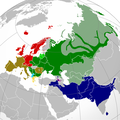Tập tin:Indo-European branches map.png

Kích thước hình xem trước: 599×600 điểm ảnh. Độ phân giải khác: 240×240 điểm ảnh | 479×480 điểm ảnh | 767×768 điểm ảnh | 1.023×1.024 điểm ảnh | 2.045×2.048 điểm ảnh | 2.934×2.938 điểm ảnh.
Tập tin gốc (2.934×2.938 điểm ảnh, kích thước tập tin: 2,16 MB, kiểu MIME: image/png)
Lịch sử tập tin
Nhấn vào ngày/giờ để xem nội dung tập tin tại thời điểm đó.
| Ngày/giờ | Hình xem trước | Kích cỡ | Thành viên | Miêu tả | |
|---|---|---|---|---|---|
| hiện tại | 03:43, ngày 26 tháng 9 năm 2022 |  | 2.934×2.938 (2,16 MB) | Alexikoua | minor fixes |
| 15:58, ngày 30 tháng 3 năm 2022 |  | 2.934×2.938 (1,74 MB) | Whoop whoop pull up | Whoops, wrong file! | |
| 15:37, ngày 30 tháng 3 năm 2022 |  | 2.048×2.048 (980 kB) | Whoop whoop pull up | Misc fixes (Russian minority in Svalbard & Israel, Slovenian in SE Carinthia, Greek in N Epirus, Aromanians/Megleno-Romanians, Swedish essentially extinct in Estonia, etc. | |
| 09:37, ngày 22 tháng 12 năm 2021 |  | 2.934×2.938 (1,74 MB) | Ahmet Q. | Reverted to version as of 19:55, 23 August 2021 (UTC)seek consensus for your changes | |
| 20:40, ngày 25 tháng 11 năm 2021 |  | 2.934×2.938 (2,16 MB) | Alexikoua | rv elimination of Greek minority in Albania | |
| 19:55, ngày 23 tháng 8 năm 2021 |  | 2.934×2.938 (1,74 MB) | Ahmet Q. | Rv false edit summary. Overrepresentation of Greeks in Turkey, Albania and Ukraine. Unexplained removal of Romanian in Serbia. Overall deterioration of the original file. Seek consensus for your changes. | |
| 16:16, ngày 7 tháng 8 năm 2021 |  | 2.934×2.938 (2,16 MB) | Demetrios1993 | Addition of Arbereshe linguistic minority in Sicily. Addition of Serbian, Bosnian, and Gorani linguistic minorities in Kosovo. Addition of Greek linguistic minorities in Italy, Albania, Turkey, and Ukraine. Including some other minor corrections. | |
| 17:00, ngày 19 tháng 11 năm 2020 |  | 2.934×2.938 (1,74 MB) | Golden | update Armenian | |
| 18:42, ngày 31 tháng 3 năm 2018 |  | 1.479×1.479 (574 kB) | Maphobbyist | Removed area that exactly corresponds to the non-Indo European Lezgi linguistic area. | |
| 21:37, ngày 6 tháng 9 năm 2016 |  | 1.479×1.479 (620 kB) | Rob984 | Georgia and Azerbaijan aren't majority multilingual. Older generations speak Russian from the Soviet era but now English is taught mainly in place of Russian. More people speak English in Finland, yet that isn't coloured. Also corrections to Celtic are... |
Trang sử dụng tập tin
Chưa có trang nào ở Wikipedia tiếng Việt liên kết đến tập tin này.
Sử dụng tập tin toàn cục
Những wiki sau đang sử dụng tập tin này:
- Trang sử dụng tại ast.wikipedia.org
- Trang sử dụng tại ban.wikipedia.org
- Trang sử dụng tại be-tarask.wikipedia.org
- Trang sử dụng tại be.wikipedia.org
- Trang sử dụng tại bg.wikipedia.org
- Trang sử dụng tại cs.wikipedia.org
- Trang sử dụng tại da.wikipedia.org
- Trang sử dụng tại de.wikipedia.org
- Trang sử dụng tại en.wikipedia.org
- Trang sử dụng tại en.wikiversity.org
- Trang sử dụng tại es.wikipedia.org
- Trang sử dụng tại et.wikipedia.org
- Trang sử dụng tại eu.wikipedia.org
- Trang sử dụng tại fa.wikipedia.org
- Trang sử dụng tại fi.wikipedia.org
- Trang sử dụng tại frr.wikipedia.org
- Trang sử dụng tại fr.wikipedia.org
- Trang sử dụng tại gl.wikipedia.org
- Trang sử dụng tại gu.wikipedia.org
- Trang sử dụng tại gv.wikipedia.org
- Trang sử dụng tại hak.wikipedia.org
- Trang sử dụng tại he.wikipedia.org
- Trang sử dụng tại hy.wikipedia.org
- Trang sử dụng tại hyw.wikipedia.org
- Trang sử dụng tại ilo.wikipedia.org
- Trang sử dụng tại incubator.wikimedia.org
- Trang sử dụng tại io.wikipedia.org
Xem thêm các trang toàn cục sử dụng tập tin này.

